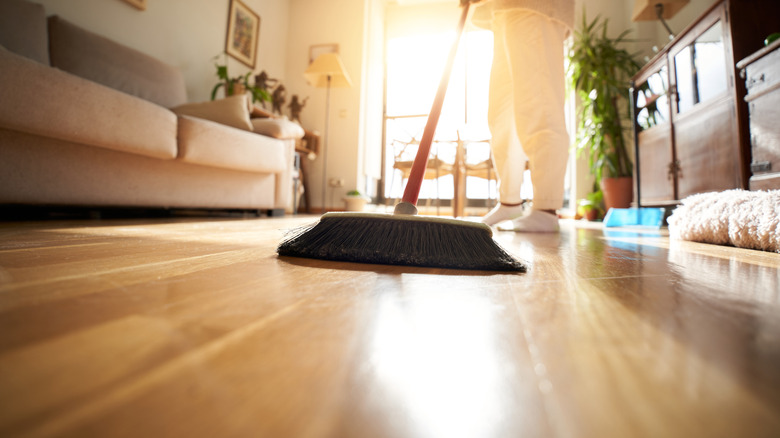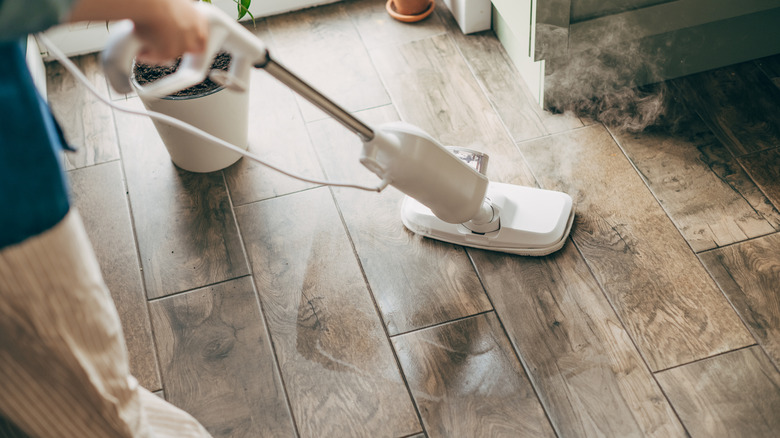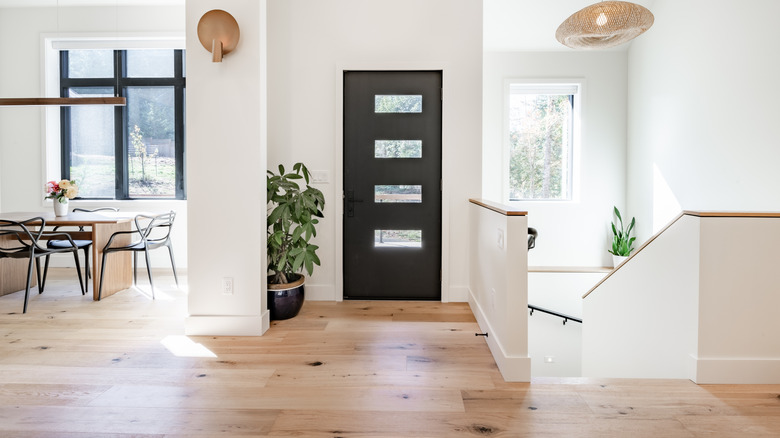Cleaning Mistakes That Will Ruin Engineered Hardwood Floors
Engineered hardwood floors give you all the beauty of solid hardwood with a hidden secret: beneath the veneer made of hardwood is durable plywood. The result is beautiful hard-surface flooring that looks like solid wood while offering increased performance in certain areas. Your engineered wood floors hold up better than solid wood against moisture and temperature fluctuations, which reduces the chances of warping and buckling that can happen in those situations. That's why engineered hardwood is a better alternative in areas where you should avoid installing hardwood floors like bathrooms and kitchens.
But that doesn't mean your engineered hardwood floors are impermeable and immune to damage. Your cleaning routine could expose your warm, inviting floors to harsh damage that leaves them looking dull or completely destroyed. Water and steam are particularly hard on engineered hardwood, but using harsh chemicals and tools or failing to clean the floor regularly can also damage the surface.
Don't let the fear of damage keep you from cleaning your floors regularly. It's an essential maintenance task that lets the natural beauty of the floors shine through. If you avoid cleaning, the floors will become dirty and dull, but they could also pose a health risk to your family. Allergens and bacteria can build up on the surface as can chemicals like pesticides that you pick up on your shoes. Cleaning regularly and avoiding common mistakes help you create a healthier environment while preventing damage to your floors.
Forgetting to sweep or vacuum
Skipping routine cleaning tasks like sweeping, vacuuming, and cleaning up spills puts your engineered wood floors at risk. Ignoring those crumbs and dirt piles could increase the risks of scratches if hard particles get dragged across the surface. Failing to clean up regularly also puts your floors at risk for damage or stains if the gunk gets ground into the surface. Any debris that's damp can cause water damage to your engineered wood floor. If you're not sweeping or vacuuming your floor at least three times a week and mopping at least weekly, you could notice dull, damaged floors. One of the downsides of engineered wood flooring is that it can't be sanded and refinished repeatedly like solid hardwood, so preventing little scratches with your cleaning routine helps the floors last longer.
Before you grab just any tool to remove dirt from the floor, keep in mind that brooms, brushes, or vacuum attachments that are too hard or abrasive could scratch the surface. Avoid an overly stiff broom or brush, instead opting for softer bristles that can sweep effectively without destroying the finish. If you use a vacuum, switch it to the hardwood or bare floor setting to shut off the beater bar and prevent dings and scratches. Soft brush attachments help you reach nooks and corners with the vacuum.
Applying too much water or using steam
Engineered wood flooring has a slight edge over solid hardwood when it comes to moisture resistance. But that doesn't mean you should slap a sopping wet mop on it when you clean. Your engineered wood floors will still expand, contract, and warp if they're exposed to too much water. Since it's not solid, engineered wood can also delaminate or pull away from the backing material if it becomes too wet.
Water damage often comes when homeowners use too much water on the mop or cleaning cloth. The mop should just be damp enough to clean the floor well. Wring the mop out well before you put it on the floor and watch for drips or spills from your mop bucket. After cleaning, dry the floor immediately to remove any excess moisture that's left behind by the mop.
Add rooms with engineered wood floors to the areas to avoid when steam cleaning your home. Despite being a handy tool, a steam mop can allow moisture to penetrate deep into the flooring. Steam might seem like it applies less moisture than a wet mop, but it can also cause the wood to swell and warp. Plus, adding heat into the mix causes more potential damage because it can break down the adhesives that hold the flooring together, and heat with moisture can cause expansion and contraction. It can also remove the finish on the flooring that protects it from scratches and other types of damage.
Using harsh cleaners and tools
If you reach for the strongest cleaner you can find, you could be putting your engineered wood at risk. Bleach and ammonia are two cleaners you should avoid, whether you use them straight on the floor or choose a cleaner that contains them. They're too harsh for engineered hardwood and could cause discoloration, strip the finish, make the floors dull, or cause other types of damage. Even vinegar can be too harsh, and wax-based products or oil soaps ruin engineered wood with the residue they leave behind. Instead, use a floor cleaning product formulated for engineered wood. Cleaners should be pH-balanced if they're not made specifically for wood. The floor manufacturer may have specific product recommendations that work well with the finish used on your flooring.
Chemicals you use for other surfaces could also impact your floors. Say you're using bleach in your laundry room and the liquid spills or splashes onto the floor. Even though you're not using the bleach to clean the floors, it could still discolor or warp the material. Use caution when working with chemicals near your engineered wood floors and clean up any splashes immediately to minimize the damage.
If you notice a tough spot that doesn't wipe up easily, you might be tempted to reach for an abrasive cleaning tool, such as steel wool or a sponge with a scouring side. While those tools will help remove the spot, they'll also likely remove the protective coating and leave scratches in the surface. Patience and a little elbow grease with a soft cleaning cloth is a better approach to cleaning stubborn messes.
Ignoring preventative steps
You'll create more work for yourself and increase the risk of damaging your engineered floors by skipping preventative maintenance. That includes spending more time sweeping, vacuuming, and mopping if you don't take any steps to limit dirt and debris on the floors. Allowing family and visitors to walk through the house with dirty shoes could lead to staining and worn spots on the flooring. The shoe soles could be damaging on their own, but they can also grind or rub small particles against your flooring to cause wear or small scratches.
One rule you might want to implement to protect your floors is a no-shoe policy. Put a mat, tray, or shelf near each entrance where you can place your footwear as soon as you enter the house. This reduces how much dirt, slush, salt, and other debris from outdoors lands on your floor to minimize damaging moisture and keep potentially abrasive particles off the surface. It also helps reduce the amount of bacteria, chemicals, and allergens that enter your home.
Mats and area rugs throughout the house also minimize damage. For instance, if you have engineered hardwood in your bathroom, placing bath mats in key spots near the sink and tub cuts down on water puddles on the floor. The same is true with kitchen floor mats. If you don't require people to take off their shoes inside your home, having mats at the entrances gives them a spot to wipe off water, slush, and other gunk that's on their shoes before they walk across your engineered floors.




